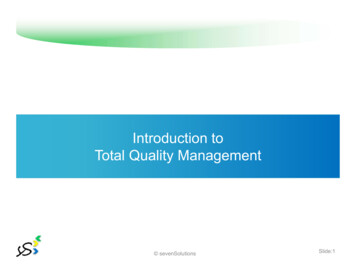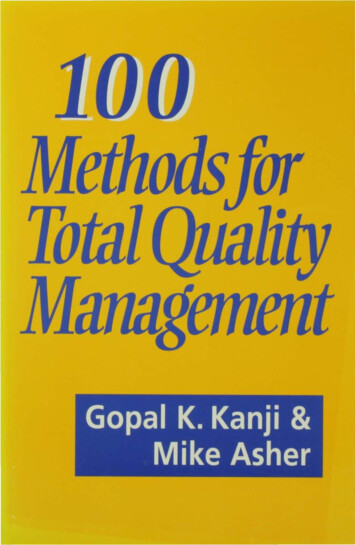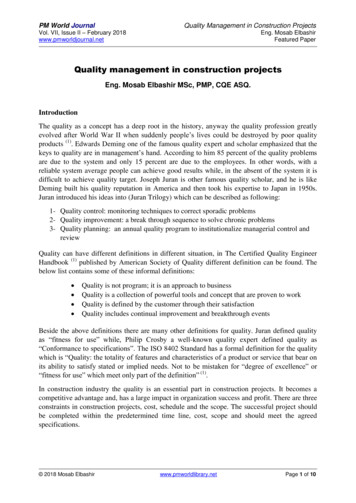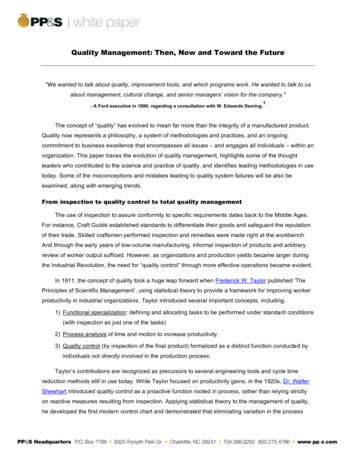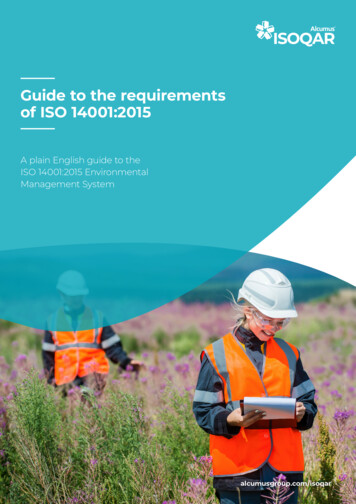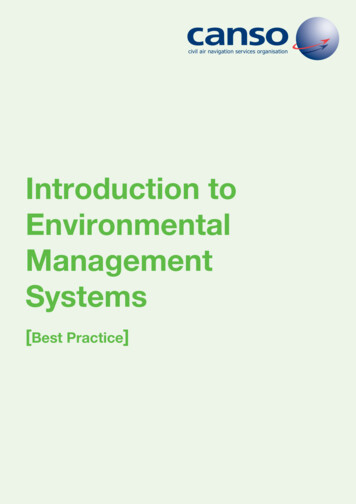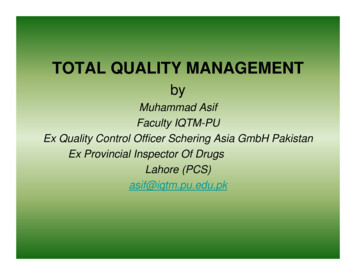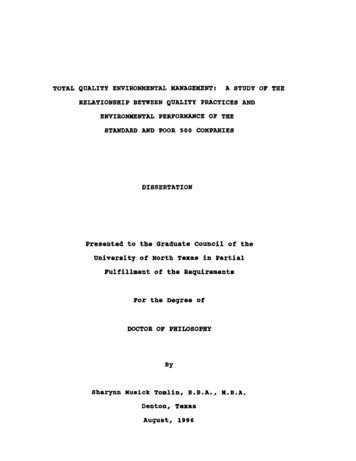
Transcription
TOTAL QUALITY ENVIRONMENTAL MANAGEMENT:A STUDY OF THERELATIONSHIP BETWEEN QUALITY PRACTICES ANDENVIRONMENTAL PERFORMANCE OF THESTANDARD AND POOR 500 COMPANIESDISSERTATIONPresented to the Graduate Council of tbeUniversity of North Texas in PartialFulfillment of the RequirementsFor the Degree ofDOCTOR OF PHILOSOPHYBySharynn Musick Tomlin, B . B . A . , M.B.A,Denton, TexasAugust, 1996
Tomlin, Sharynn Musick, Total Quality Management:Astudy of the Relationship between Quality Practices andEnvironmental Performance of the Standard and Poor 500Companies.Doctor of Philosophy (Management), August, 1996.Corporations facing escalating consumer demand forhigher product quality and foreign competitive threats, areexploring additional approaches to improve their qualitypractices.Simultaneously, increased global concern for theenvironment, coupled with tougher environmental laws, haveforced organizations to recognize their ecologicalresponsibility.As organizations address both of thesedimensions, more effective ecomanagement (Stead & Stead,1992; 1994) or total quality environmental management (TQEM)practices are being sought.Although some research has centered on ecologicalissues and how they influence management decisions andstrategies (Buchholz, et al., 1992; Hoffman, et al., 1990;Post, 1991), the body of literature is still beingdeveloped.As Shrivastava (1995) indicates, research in"how environments influence organizations, and howorganizations can procure, exploit, or compete forresources" remains nebulous.Though the realm of qualityliterature is better defined than the realm of ecomanagement
literature, the merging of the two dimensions is becomingmore prevalent.Total quality environmental management provides aframework for environmental management (Council onEnvironmental Quality, 1993; Shrivastava & Hart, 1992) andis recognized as a means of improving compliance andreducing waste and pollution (IRRC, 1995). Though currentliterature implies that a relationship exists between acompany's quality and environmental practices, researchrevealed no empirical studies substantiating thecorrelation.This dissertation is devoted to both the qualitypractices and the environmental performance of the Standard& Poor 500 companies to determine if any relationshipexisted.A literature search revealed eight factorscommonly used to measure organizational quality practices.These factors were used to measure quality practices in therespondent companies.The hypotheses formulated proposedthat a positive relationship existed between each of thequality factors and two determinants of environmentalperformance:emissions efficiency and compliance.The Standard and Poor 500 companies were surveyed todetermine quality practices and correlated with the twoenvironmental indices provided by the Investor'sResponsibility Research Center (IRRC).Results suggestedthat while there appeared to be a positive relationship
between compliance and certain quality factors, no positiverelationship existed between emissions efficiency and any ofthe eight quality factors.This study will contribute to the growing research onthe two issues of quality and the natural environment.Future research should identify an overall measure oforganizational quality and determine if any ecologicalrelationships exist.
TOTAL QUALITY ENVIRONMENTAL MANAGEMENT:A STUDY OF THERELATIONSHIP BETWEEN QUALITY PRACTICES ANDENVIRONMENTAL PERFORMANCE OF THESTANDARD AND POOR 500 COMPANIESDISSERTATIONPresented to the Graduate Council of tbeUniversity of North Texas in PartialFulfillment of the RequirementsFor the Degree ofDOCTOR OF PHILOSOPHYBySharynn Musick Tomlin, B . B . A . , M.B.A,Denton, TexasAugust, 1996
Copyright bySharynn Musick Tomlin1996in
ACKNOWLEDGEMENTSI would like to extend a sincere thank you to manypeople who were involved in this endeavor.First, andforemost, to Dr. Rose Knotts, scholar, mentor, and goodfriend, without whose help this would not have beenpossible.Second, to the members of my committee, Dr. AlanKvanli, Dr. Charles Bimmerle, and Dr. Steve Cobb whosepatience and faith was so important.Third, to otherfriends and colleagues for their support.Lastly to myfamily, Stuart, Les and Rebecca whose understanding was everpresent and will always remain the "wind beneath my wings."IV
TABLE OP CONTENTSCHAPTER 1 - INTRODUCTIONDefinitionsStatement of ProblemSignificance of ProblemChapter SummaryCHAPTER 2 - LITERATURE REVIEWQuality DefinedStrategic Importance of QualityEvolution of Quality PhilosophiesQuality FrameworksManagement Commitment to QualityRole of the Quality DepartmentTrainingProduct DesignSupplier QualityProcess ManagementQuality Data and ReportingEmployee InvolvementThe State of the EnvironmentThe Forces of ChangeEnvironmental EmissionsEnvironmental ComplianceTQEM FrameworksQuality Environmental Management (QEM)Global Environmental Initiative (GEMI)Results of TQEMMeasuring TQEMTheoretical ModelModel Variables and HypothesesChapter SummaryCHAPTER 3 - METHODResearch ProcessSample and Instrument SelectionInstrument for Quality PracticesReliabilityValidityData Used for Environmental PerformanceDesign and ProcedureStatistical PowerChapter 76. . . . 76. . . . 777981858896979798100101102103107109112
CHAPTER 4 - DATA ANALYSIS A N D RESULTSRespondent CharacteristicsContextual ResultsDemographicsData AnalysisHypotheses Related to Emissions Efficiency . . . .Hypotheses Related to ComplianceHypotheses 4, 6 & 14Hypotheses 2, 8, 10, 12 & 16Chapter Summary113113114115116118119119120123CHAPTER 5 - DISCUSSION OF RESULTSDiscussion of HypothesesHypotheses Related to Emissions Efficiency . . . .Hypotheses Related to ComplianceManagement Commitment and Compliance (H2). . . .Product/Service Design and Compliance (H8) . . . .Supplier Quality and Compliance (H10)Process Management and Compliance (H12)Employee Relations and Compliance (H16)Results InconsistenciesResearch LimitationsConstruct ValidityStatistical Conclusion ValidityRival HypothesesContributions to Current KnowledgeFuture ResearchChapter 36139143APPENDIX AAPPENDIX BAPPENDIX CAPPENDIX DLIST OF REFERENCES156
LIST OF FIGURESFigure 2.1 - Relationship of Relative Quality on ROS andROIFigure 2.2 - Deming Chain Reaction TheoryFigure 2.3 - Quality Department Organizational Chart2428. . 40Figure 2.4 - Hybrid Quality Department42Figure 2.5 - Training-Benefit Cycle44Figure 2.6 - Process RedesignFigure 2.7 - Escalation in Cost of Errors Down theProduction Line5558Figure 2.8 - A Model for Total Quality EnvironmentalManagement86Figure 3.1 - Correlation Research Process . .98
LIST OP TABLESTable l.l - Perspectives of Ecological Transformation inIndustry4Table 2.1 - Effect of Market Share and Product Qualityon Return on Investment (ROI)25Table 2.2 - Evolution of Quality27Table 2.3 - Trends in Supplier Relationships52Table 2.4 - Traditional/TQM Approaches to EmployeeInvolvement 2Table 2.5 - Summary of Literature Review64Table 2.6 - Measures of Environmental Results82Table 2.7 - Selected TQEM Measurement Systems84Table 3.1 - Reliability Coefficients for Critical QualityFactors102Table 3.2 - Summary of Hypotheses and Statistical TestsillTable 4.1 - Summary of Contextual Factors115Table 4.2 - Respondent Profile116Table 4.3 - Descriptive Statistics and Intercorrelations 117Table 4.4 - correlations Between Quality Factors andEmission EfficiencyTable 4.5 - Correlations Between Quality Factorsand ComplianceTable 4.6 - Results of Hypotheses Tested . . . . . . .119121122
CHAPTER 1INTRODUCTIONOf the global management issues faced in the lastdecade, few have caused as much concern as quality inproducts and services.Vocal consumer demands for higherproduct quality and foreign competitive threats havepersuaded firms to seek improvements, opposed to reliance onprotectionist measures, to shield their domestic markets.Equally important, is the increasing concern for theenvironment.Environmental resurgence swept throughboardrooms and was ignited by public demands andgovernmental regulation.Environmental neglect has beenreplaced by a new era of ecological awareness and inducedorganizations to find a balance between economic andeicological well-being to achieve sustainable growth.Companies are seeking new strategies to address both issues.Scholars recognizing the demise of American quality,have presented a stark synopsis of the American competitiveposition and warn businesses that they must make radicalquality changes if they hope to survive in the worldmarketplace (Grayson and O'Dell, 1988; Thurow, 1987;Milbergs, 1987).Grayson and O'Dell (1988; p. 80) predict
2that America can become the "beneficiary of this new era ofglobal competition" only if it learns to use its assets moreeffectively.Low quality inputs of capital, labor, manage-ment, and labor-management relations were cited as theculprits causing the decline of American quality.Thequestion "Can foreign firms compete with American quality"becomes, "Can American firms compete with higher qualityforeign products?"Rising competitive forces coupled with rising tradedeficits have forced American companies to improve productquality and service.A 1988 study of U.S. based companiesidentified quality as a necessary determinant of competitiveness (Morrison, 1990) and a three year study of 596manufacturing businesses found that almost every U.S.manufacturer considered its ability to offer consistentquality to be of the highest competitive importance (Ferdowset al., 1986).At the same time, organizations have been forced torecognize their environmental responsibility as the worldappears to be consuming renewal resources faster than theyare replaced.Many organizations have recognized thatecological problems cannot be understood in isolation.These problems are interconnected and interdependent, andrequire a new type of systemic, or ecological thinking to becomprehended (Lutz, 1990).Callenback et al. (1993; p. 125)believes this new thinking must be accompanied by "a shift
3in values from expansion to conservation, from quantity toquality, from domination to partnership."This transforma-tion may change the basic economic foundations as knowntoday.Lutz (1992) proposed perspectives of ecologicalchange as shown in Table 1.1 as a means of envisioning howindustry might evolve.The ecological transition from anindustrial society necessitates a change from a hierarchically, environmentally reactive, economically orientedmindset to an organic, proactive,environmentally orientedmeans of sustainable development.Lutz (1992) identifiedthe organizational components, such as strategic structure,processes, hierarchies, social groups, laws, life cycles, itc., that will be affected in this transformation.In eachof the three phases, he posits how these components changeto become more efficient through improved organizationalp r act ices.He questions earlier irresponsible industrialpractices that produced pollution.In the second and thirdphases, he outlines improved practices which can lead tosound ecomanagement.Organizations that engage in programsof ecomanagement will eventually witness a transformation ofindustrial priorities based on sustainability, rather thanexponential growth (Callenback et al., 1993).Consumers,government and industry are seeking ecologically soundproducts, performance and practices that will not merelysatisfy, but proactively address the natural environment.It is with this thought in mind that this study is written.
TABLE 1.1PERSPECTIVES OF ECOLOGICAL TRANSFORMATION IN INDUSTRYINDUSTRIAL Patriarchal, hierarchictop-down structuresChange and break ofroles, hierarchyconflictsFlexible, network-1 ikemodels, functionalleadership, synergismGrowth eqphoriaGrowth U n i t sPrinciple of sustainabilityQuantitative f i x i n g"Qualitative" growthIntegrative growthEnvironmental pollutionEnvironmental lawsEnvironmental restorationConsumption of natureEnvironmentalcompatibility testsCreation of ecologicalsystemsExploitation ofof raw materialsRecycling, savingsA r t i f i c i a l "naturalproducts"Refuse/waste problems"Intelligent 1 1 closedsystemsNature-integrativeprocessesMaterial basic tanperspectivePluralism, confettisocietyVirtual communitiesSocial lawsWelfare stateBasic securingProduct orientationExperience orientationInsight orientationMechanistic modelsCybernetic modelsSystemic nodeIsLinear Idea of tUaeTime fractionsf I t x i b i U rationParallel time structureT e r r i t o r i a l lIzationFormation of classes.Source: l u t z , "unleh: Bom Aktuell, 1992). Quoted i nEmeat Callerback a t « l , I f f f l n n t f l m t , CCA: Mrrett-Koeliler Publishers, 1995.)
5Responding to this challenge, the International Chamberof Commerce (ICC) developed a Business Charter forSustainable Developmentthat addresses issues such aspolicy setting, systems and procedures, implementation, andreporting.Today, more than 1,000 companies worldwide haveadopted the Charter with the goal of developing environmental goals. Other initiatives, such as the U.S. Chemicalindustry's Responsible Care program, are also getting moreattention in the movement toward environmentcil stewardship(Thayer, 1992).The trend toward corporate environmentalism may bestrongest overseas, where the European Community has calledfor the establishment of voluntary environmental performanceprograms throughout Western Europe.Like the ICC BusinessCharter, the regulation would require benchmark environmental audits and corporate efforts to raise environmentalstandards above compliance level (Environment Today. 1992).Historically, multinational corporations have beenviewed as part of the environmental problem in developingcountries.Within the last decade international pressures,domestic pressures, and economic globalizations haveprovided the impetus for improving environmental compliance(Long, 1991; Greeno and Robinson, 1992? Wescott, 1992).With the development of international standards forenvironmental management, quality organizations are breakingnew ground.The International Standards Organization (ISO)
6has established a taskforce to develop an environmentalstandard that will be heavily based on the British StandardInstitute's environmental management standard, BS7750.OnMarch 23, 1993, a voluntary EC environmental management andaudit regulation was adopted to promote continuous improvement in industrial environmental performance (Chynoweth andKirschner, 1993).Likewise, the U. S. American NationalStandards Institute has also embarked on the development ofan environmental standard.Central to the trade and environmental interaction isthe debate about what role the General Agreement on Tariffsand Trade (GATT) should undertake.Though GATT is confront-ing trade and environmental issues, it is on an "as needed"basis with little consensus.addressed this issue at theMultinational organizations1991 Second World IndustryConference on environmental management.The U. S. Councilfor International Business believes that GATT's majorcontribution to sustainable development can be achieved bystrengthening its ability to act as a "multilateraldiscipline" that allows and encourages nationalimplementation of environmental policies(Gavin, 1992;Sills, 1992) .Additionally, the North American Free Trade Agreement(NAFTA) has made significant inroads into harmonizingbilateral environmental and trade issues.If NAFTA issuccessful in bridging the environmental gap, it may serve
7as the example of how industrialized countries can give lessdeveloped countries assistance in taking control of theirown resources and moving their countries to produce lesspollution (Sills, 1992).increasinglyEnvironmental degradation isrecognized as one of the most serious andubiquitous problems facing mankind.The absence of theproper management of our precious resources, namely air,waterways, the sea and land, is diminishing the capacity ofthe environment to perform the indispensable service uponwhich the quality and survival of human life is dependant(Freeman et al., 1973).Strong global competition, governmental intervention,and public opinion have forced businesses to reassess bothissues.Strategic reevaluation has discovered there may bea strong relationship between quality and environmentalperformance and has given rise to a new strategic paradigmcalled total quality environmental management (TQEM) (Clair,Milliman and Mitroff, 1994; and Friedman, 1992).While theorists believe that a logical and positiveassociation exists between quality and ecologicalperformance, few studies have examined the issue.Scholarssuch as Stead and Stead (1994) and Godfrey (1993) havequestioned what factors are most critical to TQEM.Othershave noted that successful implementation of TQEM willrequire significant organizational change to integrate bothquality and ecological practices (Bleakley, 1993; Milliman
8and Clair, 1994; Post and Altman, 1992; Stead et al., 1992,1994; Wells et al., 1992).While the literature onorganizational development and change is rich with researchto support such a reformation (Lewin, 1951; Goodman et al.,1980; Daft, 1982; Miller and Friesen, 1984; Quinn, 1985;Robbins, 1983, 1987, 1990; 1993), the relationship betweenquality practices and environmental performance must firstbe established.The purpose of this study is to exploreempirically the correlation of quality practices andenvironmental performance and suggest its applicability as amodel for integrating the two fields.This developing topic is replete with new terminology.The following list of definitions should be used to clarifyand address existing and new terms used throughout thisstudy.
DefinitionsCompliance - adhering to governmental laws and regulationsregarding the impact of business on the natural environment.Ecomanagement - a systemic view of how organizations shouldbe operated to preserve the natural environment.Emissions - includes a multitude of terms; waste, sourcepollution, pollutants and toxic emissions. Although totalelimination is an admirable goal, achievement is not likely.Environment - anything that surrounds or encompassessomething else. Management literature often explains theterm contextual environment (competition, political/legal,economy, technology), but for the purposes of this study, itwill be used to refer to the natural environment, unlessotherwise stated.Environmental management - the process of planning,organizing, leading and controlling factors which affect thenatural environment. The term ecomanagement is used is themore current academic literature, while environmentalmanagement is the preferred term in practitioner literature.Environmental performance - is rated based on the decreaseof toxic emissions and the compliance with governmentalregulations.Natural environment - the surrounding biophysical or naturalenvironment of which humans and other living and nonlivingentities are a part.Sustainable competitiveness - similar to the termsustainable development, but used on the micro level as ameans of attaining organizational effectiveness throughecologically safe behavior.Sustainable development - a term popularized in aninternational report on the environment, Our Common Future.Defined as the process through which economic systems canmeet existing human wants without destroying the resourcesfuture generations will need to meet their wants.
10Statement of ProblemInstitutional ecomanagement is rapidly developingthroughout the world.Total quality management (TQM) hasevolved to total quality environmental management (TQEM).TQEM integrates environmental aspects of business with totalquality and blends environmental management into thecorporate business strategy.The compatibility of these twoconcepts is evidenced by a recent study of 15 chemicalcompanies regarding management practices and environmentalrisk (Winn & Roome, 1993).The study found that: (l)economics (cost savings) drive environmental actions, (2)companies with positive environmental records possess topmanagement commitment, written company environmentalpolicies, and statistical measurement and control systems,and (3) facility audits which focus on continuousimprovement rather than rigorous inspection.These findingsreflect the basic precepts of TQEM.If companies expect to achieve sustainablecompetitiveness, they must improve quality.At; the sametime, environmentally responsible behavior requiresdecreased wastes and compliance with stringent governmentalregulation.This paradox has prompted organizations to seeknew sustainable strategies.Specific to this study, theproblem remains how to measure quality, environmentalpeiformance, and the association of the two issues.
11In this study the relationship of effective qualitypractices and environmental performance will be examined.In general, the research question becomes: is therecorrelation between quality practices and environmentalperformance.More specifically, do companies that implementquality practices experience lower toxic emissions andhigher compliance?
12Significance of ProblemOrganizations are learning that their ecologicalmanagement practices (ecomanagement) can have a large, oftenenduring impact on corporate performance.In a recentsurvey investors ranked environmental liability as thehighest priority item in making investment decisions(GEMI/IRRC, 1992).Additionally, consumers are becomingmore environmentally conscious and demanding more sociallyresponsible products, such as recycled or green products.Though the high costs of environmental compliance canbe substantial, non-compliance can be even costlier.Forexample, the Superfund Act, as passed and later amended,establishes the protocol for handling environmentallyhazardous situations.Liability imposed by the Act isretroactive without limit, and company-owned contaminatedsites can be held accountable for 50 years.Potentialpollution liabilities may induce governmental scrutiny ofcompany balance sheets.The Environmental Protection Agency(EPA) currently sends the Securities and Exchange Commission(SEC) a list of companies with potential Superfundliabilities.Securities reporting and information services,such as Moody's Investors Service, require even morestringent company information concerning environmentalcompliance that could affect securities ratings (Bloom andMorton, 1991).While significant, Superfund does notconsider air and liquid wastes attributed to routine
13industrial operations.This type of pollution is only nowbeing addressed with pending legislation.Businesses reap three basic benefits from TQEM:alignment with business strategy,improvement, and (3)(GEMI, 1991).(1) an(2) measurable continuousa customer and supplier alignmentFirst, total quality practices applied toenvironmental management can become part of a company'sstrategy:the same tools and strategy that apply toproduction, sales, and distribution are applied toenvironmental management.Second, the basis of totalquality is continuous improvement based on fundamental databased understanding of every process.Total qualityprovides an understandable and documented guide toenvironmental management.Third, alignment betweensuppliers, customers and company, in concert with continuousimprovement, can foster environmental excellence.Thissynergy could create a more efficient company committed toproviding environmentally sound products and services.AsFriedman (1992) recapitulated, a commitment to quality, bothin the production process and environment, is essential forfirms today.One fact has emerged in the environmental era,companies that reduce environmental damage invariably rankamong the best managed and highest quality organizations inthe world (Cairncross, 1993).In 1980, Xerox establishedits commitment to the environment by creating a corporate
14environmental health and safety department.Thisenvironmental commitment resulted in Xerox Business Productsand Systems winning the 1989 Malcolm Baldrige NationalQuality Award.Arm & Hammer's commitment to the environment began atthe turn of the century when the company advocated usingrecyclable packaging.In the late 1960's, sales of Arm &Hammer skyrocketed when the company elected to manufactureand market nonphosphate detergents.Today, the company'sdetergent product is its biggest seller, and is number twoin the U.S. marketplace (Thomlison, 1992).Dupont's TQEM program is evidenced by the company'sdevelopment of a "state-of-the-art" tetrahydrofuran plant inSpain.It is expected that new technologies employed in theplant will cut organic compound emissions by 99 percent.While TQEM costs are not always easy to identify, AlliedSignal has witnessed lowered costs "because accidents costmoney."The company has claimed a 10 percent annualreduction in environmental incidents and a 50 to 60 percentdecrease in hazardous waste (Kirschner, 1992).Other examples of companies that are applying TQMpractices to theirKodak and 3M.environmental programs include EastmanEastman Kodak has been able to eliminate morethan 500,000 pounds of waste material resulting insubstantial cost savings.At 3M, emissions to air, water,and land was reduced by one billion pounds, saving about
15 480 million in wasted materials and pollution control costs(Willums & Goluke, 1992).Cross fertilization of environmental and qualityprograms has resulted in environmental leadership thatrepresents the application of TQEM principles.This crosspollination is moving TQEM to a level of strategic planningimportance.First, TQM has enabled communication ofenvironmental management issues to top management in a lesstechnically oriented language. Second, TQM has demonstratedto environmental management the importance of a customerfocus through cost savings and revenue increases.If thetrend continues, the environment could be managed as aprofit center.Lent and Wells (1992, p. 20) warn "This isimpossible until cost and revenue-related outcomes ofenvironmental performance are measured and linked."Additionally, company alliances are forming to addressthe issue of quality and the environment.One suchorganization, Global Environmental Management Initiative(GEMI), teaches organizations how to protect the environmentby using sound quality practices.GEMI is an alliance ofcompanies, mostly multinationals, formed in 1989 from agroup of 200 Business Roundtable CEOs.Today, GEMI includes24 member companies and strives to make companies aware thatgood environmental management and TQM contribute toprofitability.
16The environment will become more of a dominantcorporate issue as the market and regulations become moresophisticated.In a 1990 survey of major industrialcorporations, Deloitte & Touche found that 45 companiessurveyed saw the strategic importance of environmentalissues as critical.In addition to regulation, emergingmarkets for environmental product quality, competitivepressure, and global change remain strong driving forces.
17Chanter SummaryGrowing concern in both the domestic and globalmarketplace has forced organizations to reconsider theironce ambivalent approach to issues of quality and thenatural environment.This chapter cited numerous examplesof how various companies are acknowledging theirresponsibility to both issues.While the impact ofdeclining product quality certainly has been recognized andcasually addressed, businesses have been slow to adoptenvironmentally sound principles of management.Researchhas identified a need for empirical studies determining whatfactors impact both issues and how the process ofintegration can best be achieved.Organizations aresearching for a new way to effectively manage theenvironment.Effective ecomanagement should consider theintegration of quality and environmental performance (TQEM).The purpose of this paper is to determine if companies thathave implemented TQM practices in their respectiveorganizations experience higher levels of environmentalperformance.The following chapter will review the qualityand environmental literature separately and search for anyapplicable frameworks to integrate the two subjects.
CHAPTER 2LITERATURE REVIEWThis chapter will examine the literature from two broadand diverse subjects.First the literature on quality willbe reviewed to determine a common definition, strategicrelevance, and chronological progression of the qualityfield.The remainder of the quality review is organizedaccording to the quality dimensions (factors) mostrepresentative in the literature and exemplified in theSaraph (1989) study.Each quality practice was assessedfrom both the theoretical and application perspective.Second, the chapter presents the environmental literature toascertain the current state and importance of the ecologicalperformance of organizations.Third, examination willidentify any commonalities in the two fields and suggest aframework for the research.Quality DefinedThe subject of quality is an issue of much interesttoday and the search for a correct definition has beensomewhat elusive.According to Reeves and Bednar (1994)terms as value (Abbott, 1955; Feigenbaum, 1951), conformanceto specifications (Gilmore, 1974; Levitt, 1972), conformance18
19to requirements or zero defects (Crosby, 1979), fitness foruse (Juran, 1974, 1988), and customer satisfaction(Gronroos, 1983; Parasuraman et al., 1985).While each hasits own strengths and weaknesses, the definition of choiceis situational.After many years of study, a standard definition ofquality was adopted by the American Society for QualityControl and the American National Standards Institute.is defined as follows:It"Quality: the totality of featuresand characteristics of a product or service that bear on itsability to satisfy stated or impli
Tomlin, Sharynn Musick, Total Quality Management: A study of the Relationship between Quality Practices and Environmental Performance of the Standard and Poor 500 Companies. Doctor of Philosophy (Management), August, 1996. Corporations facing escalating consumer demand for higher product
